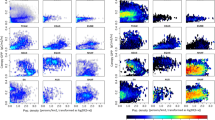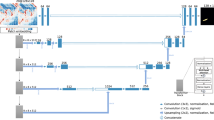Abstract
Background
Wildland fire (wildfire; bushfire) pollution contributes to poor air quality, a risk factor for premature death. The frequency and intensity of wildfires are expected to increase; improved tools for estimating exposure to fire smoke are vital. New-generation satellite-based sensors produce high-resolution spectral images, providing real-time information of surface features during wildfire episodes. Because of the vast size of such data, new automated methods for processing information are required.
Objective
We present a deep fully convolutional neural network (FCN) for predicting fire smoke in satellite imagery in near-real time (NRT).
Methods
The FCN identifies fire smoke using output from operational smoke identification methods as training data, leveraging validated smoke products in a framework that can be operationalized in NRT. We demonstrate this for a fire episode in Australia; the algorithm is applicable to any geographic region.
Results
The algorithm has high classification accuracy (99.5% of pixels correctly classified on average) and precision (average intersection over union = 57.6%).
Significance
The FCN algorithm has high potential as an exposure-assessment tool, capable of providing critical information to fire managers, health and environmental agencies, and the general public to prevent the health risks associated with exposure to hazardous smoke from wildland fires in NRT.
This is a preview of subscription content, access via your institution
Access options
Subscribe to this journal
Receive 6 print issues and online access
$259.00 per year
only $43.17 per issue
Buy this article
- Purchase on Springer Link
- Instant access to full article PDF
Prices may be subject to local taxes which are calculated during checkout



Similar content being viewed by others
References
Naeher LP, Brauer M, Lipsett M, Zelikoff JT, Simpson CD, Koenig JQ, et al. Woodsmoke health effects: a review. Inhalation Toxicol. 2007;19:67–106.
Wettstein ZS, Hoshiko S, Fahimi J, Harrison RJ, Cascio WE, Rappold AG. Cardiovascular and cerebrovascular emergency department visits associated with wildfire smoke exposure in California in 2015. J Am Heart Assoc. 2018;7:e007492.
Rappold AG, Stone SL, Cascio WE, Neas LM, Kilaru VJ, Carraway MS, et al. Peat bog wildfire smoke exposure in rural North Carolina is associated with cardiopulmonary emergency department visits assessed through syndromic surveillance. Environmental Health Perspect. 2011;119:1415–20.
Reid CE, Brauer M, Johnston FH, Jerrett M, Balmes JR, Elliott CT. Critical review of health impacts of wildfire smoke exposure. Environ Health Perspect. 2016;124:1334–43.
Johnston FH, Henderson SB, Chen Y, Randerson JT, Marlier M, DeFries RS, et al. Estimated global mortality attributable to smoke from landscape fires. Environ Health Perspect. 2012;120:695–701.
Fann N, Alman B, Broome RA, Morgan GG, Johnston FH, Pouliot G, et al. The health impacts and economic value of wildland fire episodes in the. Sci Total Environ. 2018;610-611:802–9.
U.S. Environmental Protection Agency. AirNow. https://airnow.gov/. last accessed on 07/13/2020.
EPA Victoria. EPA AirWatch—Environment Protection Authority Victoria. https://www.epa.vic.gov.au/EPAAirWatch/. last accessed on 07/13/2020.
Qin Y, Steven ADL, Schroeder T, McVicar TR, Huang J, Cope M, et al. Cloud cover in the australian region: development and validation of a cloud masking, classification and optical depth retrieval algorithm for the advanced Himawari imager. Front Environ Sci. 2019;7:20.
Mazzoni D, Garay MJ, Davies R, Nelson D. An operational MISR pixel classifier using support vector machines. Remote Sens Environ. 2007;107:149–58.
Long J, Shelhamer E, Darrell T. Fully convolutional networks for semantic segmentation. Proc IEEE Comput Soc Conf Comput Vis Pattern Recognit. 2015;3431–40.
Iglovikov V, Accord T, Mushinskiy S, Aerostate VO. Satellite imagery feature detection using deep convolutional neural network: a kaggle competition. ArXiv. 2017; arXiv:1706.06169.
Marmanis D, Wegner JD, Galliani S, Schindler K, Datcu M, Stilla U. Semantic segmentation of aerial images with an ensemble of CNNS. ISPRS Annals of Photogrammetry, Remote Sensing and Spatial Information Sciences, Volume III-3, 2016, pp. 473–80.
Zhang L, Zhang L, Kumar V. Deep learning for remote sensing. Data IEEE Geosci Remote Sens Mag. 2016;4:22–40.
Henry C, Majid Azimi S, Merkle N. Road segmentation in SAR satellite images with deep fully-convolutional neural networks. ArXiv. 2018; arXiv:1802.01445. https://doi.org/10.1109/LGRS.2018.2864342.
Huang H, Deng J, Lan Y, Yang A, Deng X, Zhang L. A fully convolutional network for weed mapping of unmanned aerial vehicle (UAV) imagery. PLoS ONE 2018;13:e0196302. https://doi.org/10.1371/journal.pone.0196302.
Li R, Liu W, Yang L, Sun S, Hu W, Zhang F, et al. DeepUNet: a deep fully convolutional network for pixel-level sea-land segmentation. ArXiv. 2017; arXiv:1709.00201.
Rizaldy A, Persello C, Gevaert CM, Oude Elberink SJ. Fully convolutional networks for ground classification from lidar point clouds. In 2018 ISPRS TC II Mid-term Symposium “Towards Photogrammetry 2020”, 4–7 June 2018, Riva del Garda, Italy (2 ed., Vol. 4, pp. 231–238). (ISPRS Annals of the Photogrammetry, Remote Sensing and Spatial Information Sciences; Vol. IV-2). Riva Del Garda: International Society for Photogrammetry and Remote Sensing (ISPRS). https://doi.org/10.5194/isprs-annals-IV-2-231-2018.
Metorological Science Center (MSC) of the Japan Meteorological Agency (JMA). JMA/MSC: Himawari-8/9 imager (AHI). http://www.data.jma.go.jp/mscweb/en/himawari89/space_segment/spsg_ahi.html. Last accessed 07/13/2020.
National Aeronautics and Space Administration (NASA). Active Fire Data—Earthdata. https://earthdata.nasa.gov/earth-observation-data/near-real-time/firms/active-fire-data. Last Accessed 07/13/2020.
Qin Y, Mitchell R, Forgan BW. Characterizing the aerosol and surface reflectance over australia using AATSR. IEEE Trans Geosci Remote Sens. 2015;53:6163–82.
Broome RA, Johnston FH, Horsley J, Morgan GG. A rapid assessment of the impact of hazard reduction burning around Sydney. Med J Aust. 2016;205:407–8.
Horsley JA, Broome RA, Johnston FH, Cope M, Morgan GG. Health burden associated with fire smoke in Sydney, 2001-2013. Med J Aust. 2018;208:309–10.
Acknowledgements
This research is being supported by funding from the Joint Fire Science Program. Ivan Hannigan was supported by funding from The Centre for Air Pollution, Energy and Health Research (www.car-cre.org.au, an Australian National Health and Medical Research Council funded Centre for Research Excellence, APP1030259), and by funding from the United States Department of the Interior and the United States Fire Service through the Joint Fire Science Program (ID: 14-1-04-9).
Author information
Authors and Affiliations
Corresponding author
Ethics declarations
Conflict of interest
The research described in this article has been reviewed by the Center for Public Health and Environmental Assessment, U.S. Environmental Protection Agency and approved for publication. Approval does not signify that the contents necessarily reflect the views and the policies of the Agency, nor does mention of trade names of commercial products constitute endorsement or recommendation for use. The authors declare that they have no conflict of interest.
Additional information
Publisher’s note Springer Nature remains neutral with regard to jurisdictional claims in published maps and institutional affiliations.
Supplementary information
Rights and permissions
About this article
Cite this article
Larsen, A., Hanigan, I., Reich, B.J. et al. A deep learning approach to identify smoke plumes in satellite imagery in near-real time for health risk communication. J Expo Sci Environ Epidemiol 31, 170–176 (2021). https://doi.org/10.1038/s41370-020-0246-y
Received:
Revised:
Accepted:
Published:
Issue Date:
DOI: https://doi.org/10.1038/s41370-020-0246-y
Keywords
This article is cited by
-
Application of Remote Sensing Technology in Wildfire Research: Bibliometric Perspective
Fire Technology (2024)
-
Implementing Geospatial Science and Technology to Get to Zero New HIV Infections
Current HIV/AIDS Reports (2023)
-
Multivariate fire risk models using copula regression in Kalimantan, Indonesia
Natural Hazards (2022)
-
A hybrid deep learning model by combining convolutional neural network and recurrent neural network to detect forest fire
Multimedia Tools and Applications (2022)



